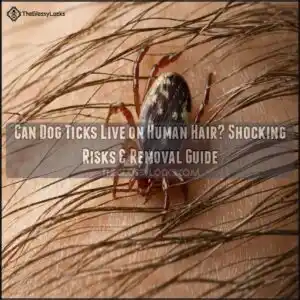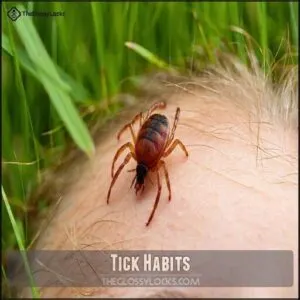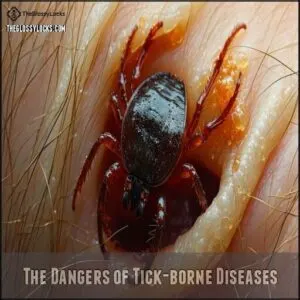This site is supported by our readers. We may earn a commission, at no cost to you, if you purchase through links.

Ticks typically attach to your scalp temporarily rather than setting up camp long-term. They’re looking for a blood meal, not a permanent address.
You’ll want to check your hairline and behind your ears after outdoor adventures, especially if you’ve been playing with tick-prone pets. While finding one in your locks isn’t common, it’s important to remove them properly to prevent disease transmission.
The right removal technique can make all the difference between a simple nuisance and a health concern.
Table Of Contents
- Key Takeaways
- Tick Habits
- Tick Infestation in Human Hair
- The Dangers of Tick-borne Diseases
- How to Remove a Tick From Hair
- Preventing Tick Infestations in Hair
- Frequently Asked Questions (FAQs)
- Are dog ticks dangerous?
- What are the best ways to remove ticks from dogs?
- Can dog ticks cause diseases in humans?
- Can dog ticks bite humans?
- Do dog ticks eat humans?
- Can ticks survive in a house?
- Are ticks more active in certain seasons?
- Can ticks spread from one person to another?
- How can I tell if I have a tick infestation?
- Is tick prevention different for pets and humans?
- Conclusion
Key Takeaways
- Dog ticks can attach to your scalp temporarily for a blood meal, but they don’t typically set up permanent residence in human hair unlike they do with pets.
- You’re at risk for serious tick-borne diseases like Rocky Mountain spotted fever, Lyme disease, and Powassan virus if ticks attach to your scalp—with Powassan potentially transmitting in as little as 15 minutes.
- To safely remove a tick from your hair, part your hair carefully, grasp the tick with fine-tipped tweezers as close to your skin as possible, and pull upward with steady pressure until it releases completely.
- You’ll prevent tick infestations in your hair through regular post-exposure checks, prompt showering after outdoor activities, applying tick-specific repellents before heading outdoors, and wearing protective hairstyles or hats.
Tick Habits
Four key habits make dog ticks particularly concerning for humans.
These tiny arachnids can’t jump or fly but excel at host-seeking, patiently waiting on grass tips to detect your vibration, heat, and scent.
Their feeding duration typically lasts 3-10 days, and they prefer grassy areas with low vegetation near trails.
I’ll create a short, engaging blockquote in the same tone as the paragraph about tick feeding duration:
Ticks lurk patiently in trail-side vegetation, waiting days for their next blood meal—an unsuspecting passerby.
Dog ticks display peak seasonal activity in spring and summer, when their habitat preferences align with human outdoor recreation.
Despite their name, they’ll happily attach to your scalp if given the chance.
Their impressive tick lifespan—surviving up to 2-3 years without food—makes prevention essential, highlighting the need for awareness of these ticks’ ability to thrive in human outdoor recreation areas.
Tick Infestation in Human Hair
While ticks typically prefer animals, they can certainly find their way to human hair, particularly on the scalp. Unlike lice, ticks don’t permanently live in human hair but can attach there after outdoor exposure.
Your hair’s density can impact tick infestation severity, creating perfect hiding places for these parasites. Here’s what you should know:
- Ticks are drawn to warm, moist areas like the scalp
- Just one tick can create a serious infestation problem
- Human hair density affects tick removal difficulty
- Ticks don’t lay eggs in human hair
- Regular hair washing helps prevent human tick infestation
Check your scalp carefully after spending time outdoors, especially in wooded areas.
The Dangers of Tick-borne Diseases
You’re at risk of serious health problems when ticks hiding in your hair transmit diseases like Rocky Mountain spotted fever, Lyme disease, or Powassan virus.
These conditions can cause symptoms ranging from fever and joint pain to severe neurological issues if not treated promptly, which can lead to serious health problems.
Spotted Fever
Rocky Mountain spotted fever (RMSF) represents one of the most dangerous tick-borne illnesses you might encounter when dog ticks attach to your hair.
This potentially fatal disease is primarily transmitted by American dog ticks, which can easily latch onto your scalp without notice.
RMSF symptoms typically appear within 2-14 days after a bite and include high fever, severe headache, muscle aches, and a distinctive spotted rash that often begins on wrists and ankles.
The disease severity increases rapidly without proper treatment.
Diagnosis methods include blood tests and skin biopsies, while treatment options primarily involve antibiotics like doxycycline.
Early intervention is critical—if you experience these symptoms after finding a tick in your hair, seek medical attention immediately.
Tick transmission occurs through saliva during feeding, which is why prompt removal of these pests from human hair is essential to prevent this serious tick-borne illness.
Lyme Disease
Every year, thousands of Americans contract Lyme disease, the most common tick-borne illness in the United States.
When infected black-legged ticks latch onto your skin or hair, they can transmit the Borrelia burgdorferi bacterium.
Initial Lyme symptoms often include fever, fatigue, headache, and a distinctive bull’s-eye rash around the bite site.
Without prompt treatment, disease transmission progresses beyond these early warning signs to affect your joints, heart, and nervous system.
Treatment options typically involve a 2-4 week course of antibiotics, most effective when started early.
The long-term effects of untreated Lyme disease can be devastating, so don’t take chances with tick bites.
Your best defense against this tick disease is prevention—wear protective clothing, use repellents, and check your body thoroughly after outdoor activities.
Powassan Virus Disease
While Lyme disease is concerning, another serious threat lurking in those tiny parasites is Powassan virus disease. This rare but potentially devastating tick-borne illness can have severe consequences if dog ticks make their way to your human hair.
The Powassan virus disease transmission timeline is alarmingly short—unlike Lyme disease, which typically requires 24+ hours of attachment, Powassan can be transmitted in as little as 15 minutes after a tick bite.
The neurological impact can be severe:
- Fever and headache often appear first, followed by vomiting and weakness
- Confusion and memory problems may develop as the virus attacks the brain
- Seizures or even paralysis can occur in severe cases
- About 10% of cases with serious neurological symptoms are fatal
Diagnostic challenges arise because symptoms can mimic other illnesses. Treatment options are limited to supportive care—there’s no specific antiviral therapy for Powassan. Prevention remains your best defense against this tick-borne illness finding its way through your hair.
How to Remove a Tick From Hair
Finding an unwelcome hitchhiker in your hair can be alarming after enjoying the outdoors.
An unexpected tick in your hair can turn outdoor fun into a serious health concern—act fast to protect yourself.
Here’s how to safely perform tick removal from human hair:
- Part your hair carefully to locate the tick and get better visibility of the bite area
- Grasp the tick with fine-tipped tweezers as close to your skin as possible
- Pull upward with steady, even pressure until the tick releases completely
- Clean the bite area thoroughly with rubbing alcohol or soap and water
- Dispose of the live tick by flushing it or sealing it in a container
Don’t twist or crush the tick during removal—this proper tweezers technique prevents disease transmission.
For ideal results, consider using high precision tools to ensure a safe and effective removal process, which is crucial for preventing the transmission of diseases, making safe removal a top priority.
Preventing Tick Infestations in Hair
Outdoorsy folks need a solid defense against unwanted hair hitchhikers. After spending time in nature, conduct thorough Post-Exposure Checks of your scalp and body.
Regular Grooming and Scalp Hygiene are your first lines of defense—comb hair carefully and shower promptly. Apply tick-specific Repellent Application on exposed skin and clothing before heading out.
You can find an effective tick control product for this purpose. Protective Hairstyles like braids or hats create barriers against tick attachment.
For home protection, keep grass trimmed and treat your yard’s perimeter. Tick prevention isn’t just seasonal—it’s a year-round commitment that safeguards your family from dangerous tick-borne diseases.
Frequently Asked Questions (FAQs)
Are dog ticks dangerous?
You thought your pooch’s hitchhikers were just freeloaders?
Think again! Dog ticks can transmit serious diseases like Rocky Mountain spotted fever and Lyme disease to you.
Remove them promptly to reduce your infection risk.
What are the best ways to remove ticks from dogs?
Use fine-tipped tweezers to grasp the tick close to your dog’s skin, then pull straight up with steady pressure. Don’t twist or jerk, as this might leave tick parts behind.
Can dog ticks cause diseases in humans?
Yes, dog ticks can transmit serious diseases to you through their bites, including Rocky Mountain spotted fever, tularemia, and sometimes Lyme disease.
You’ll need prompt removal to reduce your infection risk.
Can dog ticks bite humans?
While these unwelcome visitors normally prefer canine companions, dog ticks can indeed take a bite out of humans when opportunity knocks.
You’ll often find them hitching rides on your skin during outdoor adventures.
Do dog ticks eat humans?
Dog ticks don’t eat humans.
They’re parasites that feed on blood by attaching temporarily to your skin.
Unlike mosquitoes that quickly bite and leave, ticks embed themselves and slowly extract blood over several days.
Can ticks survive in a house?
Ticks can survive in your house for an eternity!
They’ll live indoors for weeks or months in carpets, furniture, and cracks.
Without hosts, they’ll eventually die, but they’re surprisingly resilient when waiting for their next meal.
Are ticks more active in certain seasons?
You’ll notice ticks become most active during spring and summer when temperatures warm up.
They’re less prevalent in winter but can survive in mild conditions.
Check yourself and pets more frequently during warmer months.
Can ticks spread from one person to another?
Imagine passing ticks like a hot potato! No, ticks can’t spread directly between people. They must first detach from one host and find another. You’re safe from person-to-person transmission.
How can I tell if I have a tick infestation?
You’ll spot tick infestations if you find multiple ticks on your body, unexplained itching, tiny dark spots in bedding, or clusters of red bumps on skin.
Regular body checks are your best defense.
Is tick prevention different for pets and humans?
You’ll need a fortress of different defenses for your furry friends versus yourself.
Your pets need special medications and collars, while you’ll rely on repellents, clothing, and regular body checks after outdoor adventures to protect against pests and ensure your safety with repellents.
Conclusion
Ultimately, while dog ticks can live on human hair temporarily, you’re not their preferred real estate market.
Armed with proper prevention techniques and removal tools, you’ll minimize your risk of unwelcome scalp squatters.
Remember to check thoroughly after outdoor adventures, especially when your furry companions tag along.
By staying vigilant and acting quickly when spotting these bloodthirsty hitchhikers, you’ll protect yourself from tick-borne diseases that far outweigh the initial "ick" factor of finding one camping in your locks.






